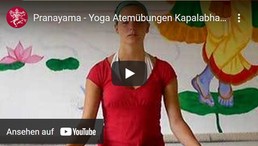

Breathing Techniques
This is just for the beginning. Later there are detailed descriptions of «Kapalabhati», «Rapid Breathing», and «Anuloma Viloma», «Alternate Breathing».
Table of Contents
1 Kapalabhati — the Rapid Breathing
1.1 Basic Instructions
1.2 Effects of Kapalabhati (Rapid Breathing)
1.2.1 Physically
1.2.2 Energetically
1.2.3 Mentally
2 Anuloma Viloma — the Alternating Breathing
2.1 Basic Instructions
2.2 Effects of Anuloma Viloma (Alternating Breathing)
2.2.1 Physically
2.2.2 Energetically
2.2.3 Mentally
Kapalabhati and Alternating Breathing

 |
 |
Kapalabhati — the Rapid Breathing
«Kapalabhati» (Sanskrit: kapālabhāti) literally means light, glisten, shining (Bhati) of the skull (Kapala) or «Brightening Skull». «Kapalabhati» means in Yoga and Ayurveda a Breathing Exercise of the «Pranayama» with a rapid succession of strong exhalations and automatic inhalations. «Kapalabhati» is one of the six Shatkriyas. «Kapalabhati» is one of the most popular and most effective Breathing Exercises («Pranayama»Pranayama) in Yoga.
 Also Tratak, the Candle Meditation belongs to the Shatkriyas
Also Tratak, the Candle Meditation belongs to the Shatkriyas
On a physical level, «Kapalabhati» releases, among other things, the Paranasal Sinuses and helps to reduce Kapha (mucus). On an energetic level, «Kapalabhati» activates the «Prana», on the mental level it helps to a clear mind.
A breathing exercise for more oxygen, energy and mental clarity
«Kapalabhati» («Rapid Breathing», also called Fire Breathing) is the First Breathing Exercise («Pranayama») in the Yoga Vidya Series. It follows directly on the Initial Relaxation or the Introduction Mantras. After «Kapalabhati» follow the «Alternate Breathing».
«Kapalabhati» can also be practiced on its own.
Classically, this are practiced on sitting down. But you can this also practice on standing or even on walking.
Basic Instructions
1. Starting Position: Sit straight, eyes closed.
2. Inhale for 3-4 seconds, bringing belly out. Then exhale for 3-4 seconds, bringing belly in. Breathe so for about 3-8 breaths.
3. Then start with the actual «Kapalabhati»: Breathe out very quickly (max. 1/4 - 1/2 second) and relaxed twice as slowly in (usually it's enough to let the breath flow in by itself). Repeat about 20-100 times.
4. Then breathe in and out 1-2 times. Then breathe in comfortably and fill the lungs 3/4. Hold the air. Concentrate you to the abdomen, the spine, the point between the eyebrows or the skull. Hold the air as long as you are comfortable (20-120 seconds). Then breathe normally in and out 2-4 times and then continue with the next round. Practice 1-5 rounds, classical are 3 rounds.
Effects of Kapalabhati (rapid breathing)
Physically
➳«Kapalabhati» strengthens the diaphragm and respiratory muscles.
➳«Kapalabhati» cleanses the lungs and massages the heart, liver and stomach. During the period of rapid breathing, the oxygen content in the blood is greatly increased. As a result, the blood becomes alkaline (basic), which improves certain metabolic processes and purification. At breathe holding, the level of carbonic acid in the blood increases, which in turn stimulates other metabolic processes and improves lung efficiency. The time of breath holding is a training stimulus, which causes the lung capacity increases; circulation and heart activity are improved.
➳«Kapalabhati» helps to cleanse the airways (bronchi, alveoli, trachea and nasal passages) and is a good preventive measure against hay fever, asthma and colds.
➳«Kapalabhati» has a cleansing and purifying effect on the whole body.
Some students initially feel dizzy at the exercise. This is a sign that the brain is not yet used to this amount of oxygen, and often that the student smoking or has smoked. The dizziness passes but after a short time. But make sure, that the student breathes properly, especially NOT forcing the inhalation.
Energetically
«Kapalabhati» activates the solar plexus. The energy rises to the head and radiates from there. «Kapalabhati» means «Shining Skull» and refers to the feeling of energy emission from the head. One can by means of the «Mula Bandha» (root shutter = contraction of the pelvic floor muscles), the visualization and the concentration, directing the «Prana» in the «Sushumna» (subtle spine) and the «Chakras» activate.
Mentally
«Kapalabhati» activates and helps to clear the head. It is very good at eliminating mental and emotional tensions. It helps against fatigue and depression and leads to inner joy and strength.
Anuloma Viloma — the Alternate Breathing
A Breathing Exercise for inner balance and mental concentration
«Anuloma Viloma»,, the «Alternate Breathing» (also called Nadi Shodhana or Nadi Sodhana, i.e. Purification Exercise) is the Second Breathing Exercise («Pranayama») in the Yoga Vidya Series. This follows the «Kapalabhati», the «Rapid Breathing». After the «Alternate Breathing» and the Relaxation follows the Sun Prayer («Surya Namaskar»).
However, «Anuloma Viloma», the «Alternate Breathing», can also be practiced on its own.
You practice this in a comfortable Sitting Position, cross-legged, kneeling or sitting on a chair.
Basic Instructions
1. Starting Position: Sit straight, eyes closed.
2. Raise your right hand. Close the right nostril with your right thumb. Inhale through the left nostril for 4 seconds; thereby the belly goes forward. Fill the lungs about 3/4.
3. Close both nostrils with thumb and ring finger and hold the air for 4 seconds.
4. Open the right nostril and exhale through the right nostril for 8 seconds. Empty the lungs (almost) completely.
5. Keep the left nostril closed and inhale through the right nostril for 4 seconds.
6. Close both nostrils and hold the air for 4 seconds.
7. Open the left nostril and exhale through the left nostril for 8 seconds.
8. Start again from the beginning.
9. Practice at least 3-8 rounds. You can increase to 20-30 minutes, if you want.
10. Start with the Ratio Inhale : Holding : Exhale with 4 : 4 : 8.
11. Slowly increase it to 4 : 8 : 8, then 4 : 12 : 8, finally 4 : 16 : 8.
12. Advanced practitioners can even upgrade to 5 : 20 : 10, 6 : 24 : 12, 7 : 28 : 14, 8 : 32 : 16.
Effects of Anuloma Viloma (Alternate Breathing)
Physically
The «Alternate Breathing» helps to increase the lung capacity and to bring the breathing under control. Especially the periods of breath-stopping are a good training for heart and circulation. The «Anuloma Viloma», helps to open the nasal passages. The «Alternate Breathing» is excellent against allergies, hay fever and asthma; and has a preventative effect on common colds. The «Anuloma Viloma», has a harmonizing effect on all body systems.
Energetically
Nadi Shodhana means «cleaning the Nadis». All 72000 «Nadis» are opened, so that the «Prana», the life energy, can flow better. In particular, «Ida», «Pingala» and «Sushumna» are opened, solar and lunar energy in «Ida» and «Pingala» will harmonized. Through the opening of the «Sushumna», the «Prana» can flow into the higher «Chakras». By concentration, you can bring the «Prana» where you want it.
Mentally
The «Alternate Breathing» improves concentration and prepares the mind for meditation. The «Alternate Breathing» helps to find inner peace and strength. Emotional imbalances are transformed into the quiet sense of strength and power. The effects of «Kapalabhati» are felt faster; those of the «Alternate Breathing» last longer.
